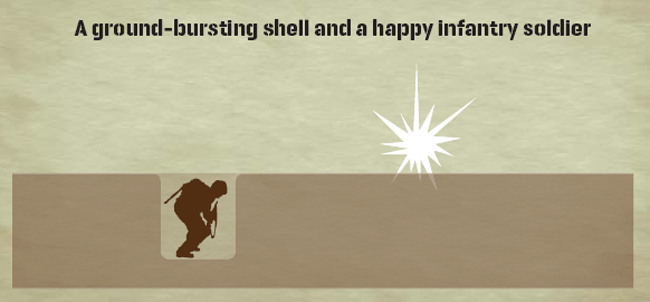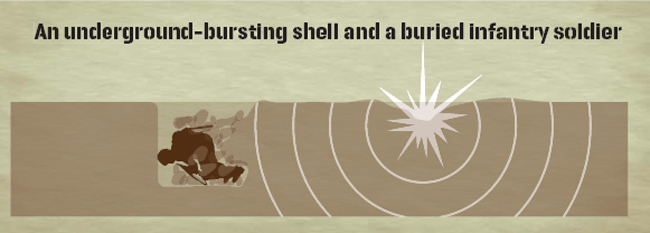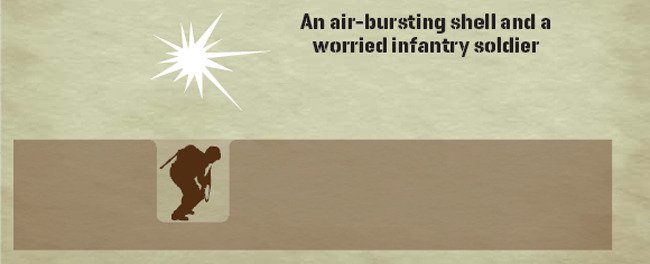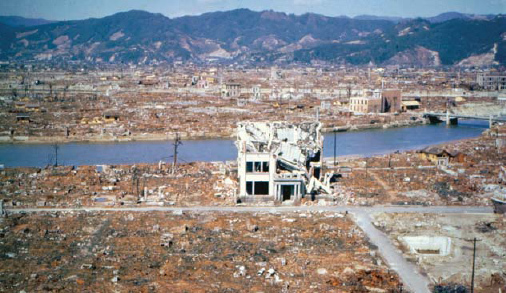High explosive ground burst
All the mortar bombs that insurgents have access to, and most artillery shells, are set with what are called ‘contact fuses’. All this means is that they explode when they hit something. This is usually the ground. Ground burst is good from your viewpoint – providing you can either get yourself flat on the ground a fair way from the point of impact or, even better, into a hole in the ground. A hole in the ground is the infantry soldier’s second best friend – after his rifle – and his natural home.
If you cannot get on the ground when a high explosive shell lands near you then you are going to be absolutely riddled with holes from the shrapnel.

The good news is that you generally have plenty of time to react to incoming mortars and artillery so ground burst is not that much of a threat unless it’s from a calibre of 155mm or higher. You won’t have to hear mortars many times to recognize what calibre they are and how far they are coming from – so you don’t have to rush needlessly.
Incoming artillery of 155mm and above sounds like a train coming into a station and is quite intimidating. The bang it makes is deafening but you are OK so long as you are in a hole and the shell is set to ground burst. Sometimes 155s will collapse your trench but fortunately they are fired from huge guns and insurgents cannot use them because they cannot be hidden from our air assets.
High explosive underground burst
The underground burst shell or bomb works by having a detonator which is triggered when it hits the ground in such a way that it sets off a very short fuse. This fuse allows the shell to bury itself before it explodes and therefore has lots of packed earth around it to push against. The problem with an underground burst is that it is always a large shell and presumably aimed to collapse your holes and trenches. Your concern here, besides being blown to pieces, is premature burial.
Fortunately, in current conflicts at least, you are more likely to win the lottery than be subjected to an underground burst. This is because the shell has to be fired from heavy artillery which terrorists don’t normally have – so don’t lose sleep over it. If you did suspect the incoming shells were set this way you would be well advised to keep your head near the surface or lay in a hollow as then would take almost a direct hit to get you.

High Explosive air burst
One of the biggest killers during World War I was air-bursting shells. Used against troops advancing in the open it is absolutely deadly. For obvious reason, one shell spreads its shrapnel out democratically so that everyone gets a share. It is even deadly if you are in an uncovered foxhole.

Do remember that air burst is unlikely to be used against you on purpose. The one time when you need to be concerned is if you choose to site your foxholes under the shade of a tree to protect against the sun or rain. In this case any mortar round or shell which hits the branches of the tree becomes an automatic air burst. You will only do this once.
The way to deal with air burst, even air burst from a sheltering tree, is to put an earth roof on your holes. It takes some work but it is wonderfully comforting to have 18in of packed earth or rock over your head.
NUCLEAR, CHEMICAL, BIOLOGICAL AND OTHER NASTIES
Most of the following toys are very unlikely ever to be used against you on the battlefield. Amongst the reasons are that they either take a great deal of trouble to make or they are very difficult to deliver properly – so they hurt the enemy rather than the user. Nevertheless I have covered the main exotic weapons groups to give you an idea of what is possible and what you just might face in counter-insurgency and other types of warfare.
Nuclear weapons
A nuclear weapon has several ways of killing you. The first and most obvious is the blast which can flatten a city. There is also the flash which sets fires or fries everything within a certain radius. Finally there is the radioactive fallout which causes burns to appear on the skin like third degree sunburn followed by sickness, the breakdown of the body’s systems and death. A hole in the ground the is the best answer to the blast and flash but a protective suit and gas mask is the only answer to the fallout. Following exposure there are drugs which can be administered to help the body survive and chemical washes which help remove contamination.
Nuclear weapons are used like conventional high explosive bombs in air, ground and underground bursts. The air burst burns and flattens a larger area but leaves little radiation to trouble occupying troops. A ground burst destroys hard targets on the ground over a wide area but contaminates that area. An underground burst is ideal for destroying the strongest of bunkers. Interestingly enough, the research in nuclear weapons is not to make them bigger and more powerful but to make them smaller and less powerful. Smaller so that they can be fired by battlefield artillery and less powerful so they can be used like super powerful high explosive just to take out a bunker complex, camp, or military grouping.
The good part is that nuclear weapons are incredibly difficult to make at all requiring huge amounts of radioactive materials and the machinery to concentrate this then the ability and science to do all manner of other things. Iran may have nuclear weapons by 2012, Pakistan already has them and may fall to the Islamic extremists shortly. North Africa is in a state of turmoil and the Islamic extremists, if they take over, may be able to obtain nuclear weapons from Iran. The days of superpowers threatening to flatten each others’ countries are probably over but there is no guarantee a rogue nation will not try to launch a few missiles at a Western nation’s cities perhaps from a submarine or surface vessel.
A terrorist group is not going to use a nuclear weapon in an insurgency campaign but they might be able to smuggle a nuclear device into a Western country. This would be extremely difficult to do and is more a concern for the security agencies than soldiers. The final reason that no insurgency campaign or country is likely to use nuclear weapons is that it would take the backing of a state or country to develop and deliver them. The CIA, MI6 and MOSSAD would immediately find out who they were because the material in the bomb has a sort of finger print which shows its origin and the US would nuke them back into the stone age. The usual suspects know that and though they may be fanatics they are not stupid.

Hiroshima, Japan, March 1946. This was a thriving city before a relatively small nuclear device was detonated above it as air burst in August 1945. (Cody)
Dirty bombs
Dirty bombs are merely a high explosive charge with some radioactive material close by – perhaps around it. They are very easy to make as appropriate radioactive material can be sourced from medical facilities but difficult to hide and transport as detection is quite easy. When detonated the blast spreads the radioactive material as dust which, if strong enough, can cause radiation sickness. It is much more likely to do nothing or perhaps cause a handful of incidents of cancer in the long term. The main purpose of such a weapon is to close down a city for an extended period while it is decontaminated and to cause panic amongst civilians. Again, you are unlikely to find these on the battlefield in counter-insurgency warfare.
Poison gas